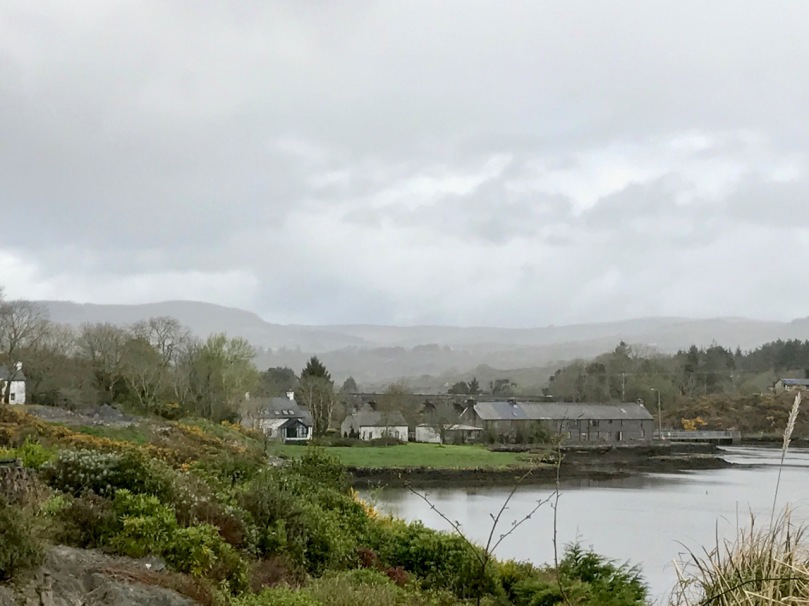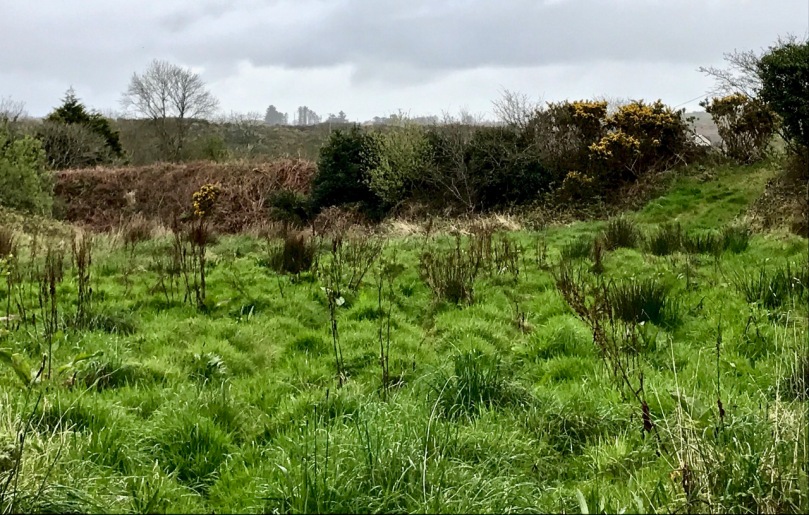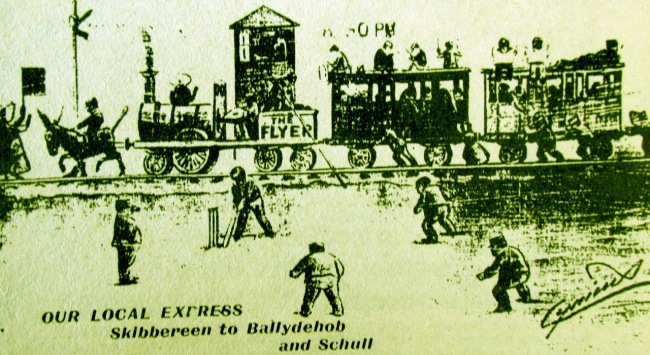Ballydehob’s own railway was known, affectionately, as The Flying Snail. Way back in 2013 I wrote a piece about it. All our past posts are still online and can be found through the search facility on the header: if you want to have a look at this older piece, click here.
Header – this picturesque bridge lies to the west of the viaduct and crosses the small back road which leads down to the Quay; the early postcard above shows a little train negotiating the viaduct, probably fairly early in the life of the line; lower picture – autumn atmospherics, taken in 2016
This morning – a pale and rather cold First of April – I set out to see how much I could find remaining of the old railway line in Ballydehob. As an erstwhile amateur industrial archaeologist I can get very excited about a few stones piled up, or a depression in the ground, as long as I know it marks the last traces of a long-lost canal or railway line. Our little West Cork settlement in fact has a whole lot to interest the transport enthusiast, as I discovered on my walk.
Today’s washed-out view of the Quay with the 12 arched viaduct behind it. This was a lifeline for the town before the railway came, and its commercial use survived the demise of the trains. In its heyday, the Quay was busy with arrivals of sand, seaweed, coal and timber, together with produce from the islands, and – once a week until the 1930s – a visit from the Cork coastal trading boat which brought in supplies of everything else, from sugar to cement. Around the mid 1800s (pre railway era) copper ore from the local West Cork mines was shipped out from here to Swansea
While researching this post I was pleased to find some additional early photos of the line that were not available when I first wrote on the subject, and I am including them on this page, with grateful thanks and acknowledgement to De La Salle Publication via Durrus History, and also to Irish Postcards at WordPress.
Ballydehob has established a public footpath on the line of the railway within the village. Top picture – the track bed to the west of the viaduct: the narrow gauge line from Skibbereen continued from here to Schull. Lower picture – the track bed crossing the viaduct over the river. The railway station was situated beyond this, quite a little way out of town
Sadly, the track-bed footpath only runs for a few hundred yards before petering out, but it is possible by walking over the viaduct to get a feel for what it was like to travel in the rather frail looking rolling stock of the 3ft gauge line, which was technically termed a ‘tramway’. If only enough of the old line had been retained to create a long-distance foot-and-cycling path, we would now have another amenity for locals and visitors to add to the wealth (food, culture, landscape and history) that’s already on offer here in West Cork.
Top left – along the boreen which runs from Ballydehob village centre (turn by Levis’ pub and go past the school) towards Cappaghglass and Schull can be found old railway bridge abutments – top right, while in the fields nearby the railway embankment is clearly visible – lower picture. Artefacts for archaeologists to ponder over a few hundred years hence, perhaps
The last train ran on the line in January 1947, so there must be many people around today who remember it in use. I am always on the lookout for anecdotes about it, so please let me know if you have any yourself, or know of anyone else who might have. There seems to be little recorded about travel on West Cork’s railways at the turn of the 19th / 20th centuries, although the train journey to ‘Skewbawn’ (Skibbereen) does get mentioned in The Irish RM story Poisson d’Avril by Somerville and Ross. It’s quoted in Finola’s post on the Rossbrin Loop, here.
Above: two views of Ballydehob Station in use. The upper one is dated 1904. The lower one is much later and – because of the bilingual station name board – probably dates from after the 1925 amalgamation of all the smaller lines into The Great Southern Railway
There are many more traces of the line to be found in Ballydehob and beyond: look out for another post coming soon!












Excellent. I love tracking old railways and their accompanying structures and buildings. Great that they’ve just opened the Deise Greenway along the old Waterford – Dungarvan line. I’m lucky enough to remember (just) the West Cork line in operation – my uncle was a level crossing keeper in Dunmanway. Robert you might be familiar with the blog ‘beneaththesummergrowth.wordpress.com’ which has uncovered and recorded a load of Irish railway archaeology.
LikeLiked by 1 person
Thank you, Roy. No, I hadn’t come across that blog so I’ll look it up. Any stories from your uncle?
LikeLike
Regrettably I didn’t listen to his stories until it was too late 🙂 I do always recall though that, when the bell rang in his cottage, signalling a train on the way, he’d always be sure to put on his uniform jacket and peaked hat before going out to open the crossing. He later worked at Cobh station and I was with him one day when he blagged free entry to the Titanic Experience saying – correctly – that the attraction was constructed on the site of the station that he’d worked at before retirement 🙂
LikeLiked by 1 person
Well Roy – there are two stories there, for a start! A lesson for us all to be out talking to people, while they are still around!
LikeLiked by 1 person
If you’re ever in Towyn in North Wales, go and have a look in the little railway museum, next to Wharf Station on the Talyllyn Railway and in the upstairs gallery, they have a section devoted to the Irish narrow gauge lines, amongst the many items are a ground signal from the S&S and the train staff and red box stamped Ballydehob.
On the ground floor is a Guinness Spence NG loco as well, gauge 1ft-10in.
Best regards.
Andrew John Waldron.
LikeLiked by 1 person
Andrew – that’s wonderful information! I had no idea that artefacts from our line had become so scattered. Don’t know whether you saw my posts about Irish canals, which mention L T C Rolt and the Tallylyn? Try this link: https://roaringwaterjournal.com/2016/08/28/green-silver/ for my review of Rolt’s book on these canals, and this link: https://roaringwaterjournal.com/tag/green-silver/ for my articles following up Rolt’s travels in Ireland. Best wishes, Robert
LikeLike
Hi Robert.
It is a book i have never read, however, you have reminded me that a friend i am going to see in two weeks has a copy, which he offered to let me have a lend on same, so this time i will take him up on that.
Enjoyed your extract from the book, it has spurned me on to see what the full book will tell.
A million thanks.
By the way i know where the S&S photos are now, i will need to scan them, hence a share with you and anyone else and i think i have a tale of woe regards one old S&S coach, that nearly made it into preservation to have survived, but rather than give you a cock a hoop version, i will dig out the notes i have, from the horse’s mouth so to speak.
More to follow in a day or so, off to the English Lakes for a little break, with my wife.
Best regards.
Andrew.
LikeLike
Hi.
You need to go and see Jim Deegan in Co Laois. He has a private 3ft gauge railway round his garden, with two very good replica Schull and Skib carriages, they are the 4w ones, made from the original drawings, one is a brake and the other a third class type.
I might have some photos of the old stock, which was sold to a farmer, i will need to look them out, if i find them, i will post them up.
Best regards.
Andrew Waldron.
LikeLiked by 1 person
Many thanks, Andrew – we certainly have to get to see this! Look forward to the photos if you have them.
LikeLike
I too have been researching routes of railways, in my case all three running out of Skibbereen; to Schull; to Baltimore; towards Cork. I have been using as a guide the comprehensive Green Lane feasibility study commissioned by Cork County Council which clearly maps, at around 1:2,500, all the routes in which I am interested. I would be surprised if you are not familiar with this document. If not however,I am sure you will find it a useful research tool.
LikeLiked by 1 person
Have been looking at these and other historic maps – and at Google Earth: the route of this line can be clearly seen in many places. This will guide us on our explorations on the ground – leading to our next post in the subject, coming soon! Many thanks for your comment – it’s really appreciated.
LikeLike
Reblogged this on West Cork History.
LikeLiked by 1 person
Reblogged this on Deep Maps : West Cork Coastal Cultures.
LikeLiked by 1 person